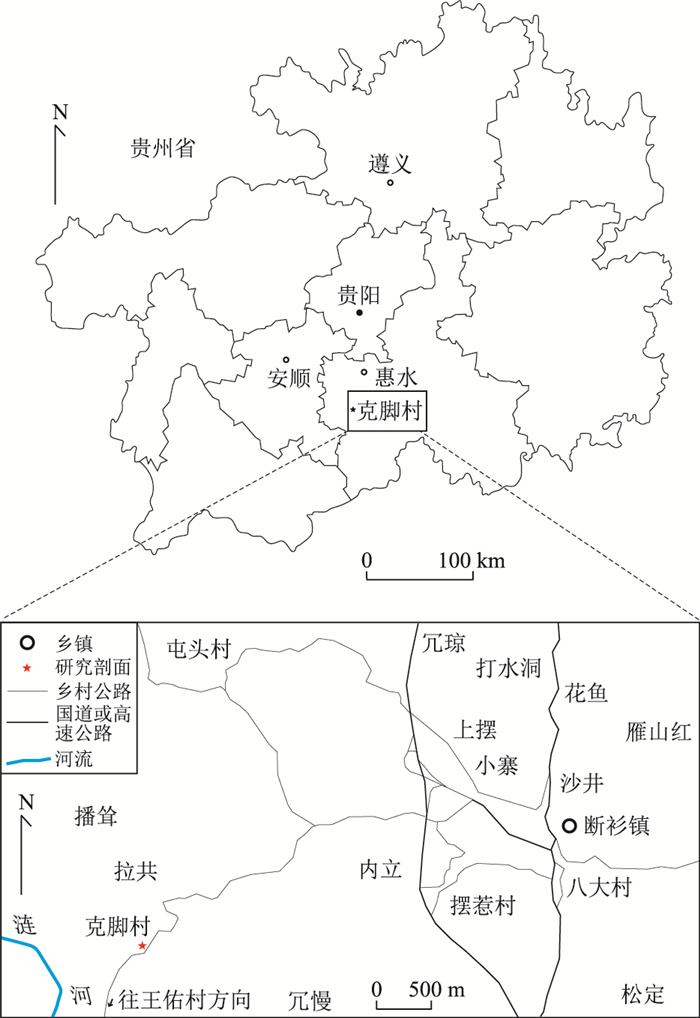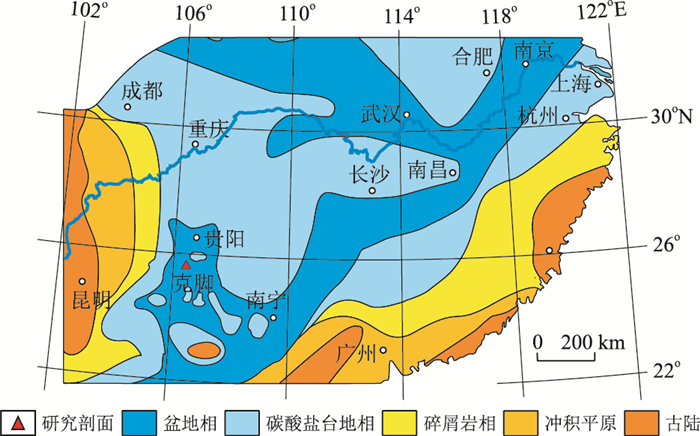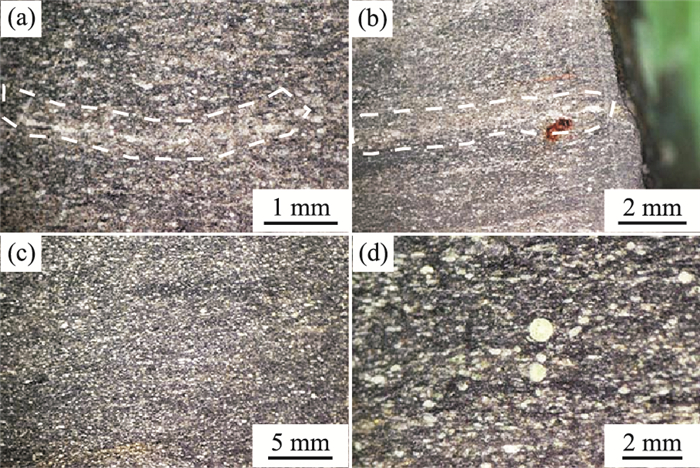End-Permian Radiolarian Fauna from North Part of Nanpanjiang Basin and Implications of Paleo-Water Depths
-
摘要: 古-中生代之交,不同古地理背景中生物灭绝的表现不同.有关放射虫动物群研究,一方面,提供古地理背景等重要信息;另一方面,为生物多样性演变的研究提供基础资料.二叠纪-三叠纪之交盆地相放射虫的研究对揭示不同沉积相生物灭绝和古环境演变具有重要意义.贵州惠水以南克脚二叠系-三叠系界线剖面位于南盘江盆地北部,为盆地相沉积.对克脚剖面大隆组和大冶组底部放射虫动物群进行了初步统计、类群组合特征分析,结合放射虫的保存状态,对克脚剖面二叠纪末古水深进行了详细研究,认为大隆组至大冶组底部地层沉积于浪基面以下,古水深普遍浅于150 m,大隆组上部最大海侵时古水深最浅达200 m左右.Abstract: The process of the Paleozoic-Mesozoic mass extinction in different paleogeographic settings is different. The research on radiolarian fauna provides not only important information for the study of paleogeographic settings but also basic information for the study of biodiversity evolution. The research on the radiolarians in the basinal facies of the Permian-Triassic transition is of great significance to reveal the mass extinction among different sedimentary facies and the paleoenvironmental evolution. The Permian-Triassic boundary section of Kejiao, Guizhou Province is located in the northern margin of the Nanpanjiang basin, which is in the basinal facies. In this paper, the preliminary statistics and taxonomy composition of the radiolarians from the Talung Formation and the basal part of Daye Formation in the Kejiao Section Were analyzed. And then the paleo-water depths of the late Changhsingian were studied in detail, based on the statistics and analysis of radiolarians and the preservation of the radiolarians. It is concluded that Talung Formation to basal Daye Formation were deposited below the wave base, and the paleo-water depths are generally considered as shallower than 150 meters. The paleo-water depths during the maximum transgression in the latest Changshingian (equivalent to the uppermost of the Talung Formation) are about/or deeper than 200 meters.
-
Key words:
- radiolarian /
- paleo-water depth /
- end-Permian /
- southern Guizhou /
- biostratigraphy
-
图 3 贵州克脚剖面岩性特征、放射虫分布与统计
“取样”为放射虫样品采集层位;“完整度”是指鉴定和统计过程中观察到的放射虫的保存状态;“分布状况”是指在垂直于岩层层面的切面方向,放射虫均匀分布或者集中分布于某个界面;修改状况“保留”是指无洋流或水流作用时,采用放射虫估计的古水深;“订正”是指有洋流或水流作用时,将深水分子认为是洋流搬运而至,不作为古水深估计的标志;海平面变化“初拟水深曲线”是未考虑洋流作用时,采用放射虫估计的古水深,“实际水深曲线”是“订正”状态下的古水深估计
Fig. 3. Lithological column of the studied section, ranges of radiolarian species and statistics
图 4 贵州克脚剖面大隆组放射虫在垂直层面方向的分布特征
a~b.放射虫集中分布在某个层面;a.样品号RL-51-3-4,产于克脚剖面第51-3层;b.样品号RL-51-3-5,产于克脚剖面第51-3层.c~d.放射虫均匀分布;c.样品号RL-64-5-6,产于克脚剖面第64-5层;d.样品号RL-64-5-7,产于克脚剖面第64-5层
Fig. 4. Distribution along the section vertical to bedding plane of radiolarians from the Talung Formation at Kejiao, Guizhou, South China
图 5 贵州克脚剖面大隆组放射虫
所有比例尺为100 μm.a~b.Neoalbaillella cf. optima;a.RL-57-1-6;b.RL-64-1-48.c~d.Neoalbaillella sp.;c.RL-64-4-56;d.RL-64-4-59.e~g.Albaillella hushanensis;e.RL-64-4-58;f.RL-64-1-43;g.RL-66-1-9.h.Albaillella triangularis, RL-66-1-27. i~k.Quadricaulis inflata;i.RL-57-1-51;j.RL-64-4-60;k.RL-64-4-62.l~n.Entactinia modesta;l.RL-64-1-45-1;m.RL-64-2-89;n.64-2-106. o.Entactinia itsukaichiensis, RL-64-2-99-1. p~q.Copicyntroides stellatus;p.RL-66-1-33;q.RL-64-2-88.r~s.Archaeospongoprunum mengi;r.RL-57-1-52;s.RL-64-4-73.t~u.Tetraspongodiscus stauracanthus;t.RL-57-1-49;u.RL-64-1-42
Fig. 5. Scanning electron micrographs of the late Changhsingian radiolarians from the Kejiao Section, Guizhou Province, South China
表 1 贵州克脚剖面大隆组放射虫相对丰度统计
Table 1. Relative abundances of radiolarians from Talung Formation from Kejiao, Guizhou Province, South China
样号 球形放射虫
(个/0.01 g)十字多囊虫
(个/0.01 g)阿尔拜虫
(个/0.01 g)68-3 1 68-2 638 68-1 135 67-1 560 4 2 66-2 3 346 11 38 64-4 4 714 10 107 64-3 3 360 8 12 64-2 2 136 13 2 61-3 1 61-2 16 60-3 0 60-2 53 59-3 200 59-2 48 58-3 288 58-2 233 57-2 2 120 57-1 769 1 55-5 1 521 55-4 555 55-3 1 310 1 55-1 29 54-4 391 1 54-3 260 54-1 176 53-5 115 53-3 3 53-2 9 53-1 30 52-5 25 52-3 884 52-2 1 52-1 27 51-4 50 51-3 3 51-2 3 50-2 3 50-1 116 49-3 1 625 49-2 572 49-1 1 107 48-4 124 48-3 214 48-2 400 48-1 962 47-3 193 47-2 379 47-1 851 46-3 1200 46-2 354 46-1 730 45-4 640 45-3 54 45-2 384 45-1 653 1 44-2 351 44-1 125 43 115 42-2 333 42-1 88 41-3 407 41-2 120 41-1 82 40-2 37 40-1 34 39-3 21 39-2 37 39-1 451 38 455 37 57 注:个/0.01 g表示每0.01 g干样中含的放射虫数量,单位为个. -
Chen, Z.Q., Shi, G.R., Gao, Y.Q., et al., 2009.A Late Changhsingian (Latest Permian) Deep-Water Brachiopod Fauna from Guizhou, South China.Alcheringa:An Australasian Journal of Palaeontology, 33(2):163-183. https://doi.org/10.1080/03115510902844210 Chen, Z.Q., Shi, G.R., Yang, F.Q., et al., 2006.An Ecologically Mixed Brachiopod Fauna from Changhsingian Deep-Water Basin of South China:Consequence of End-Permian Global Warming.Lethaia, 39(1):79-90. https://doi.org/10.1080/00241160600581764 de Wever, P., Dumitrica, P., Caulet, J.P., et al., 2001.Radiolarians in the Sedimentary Record.Gordon and Breach Science Publishers, Singapore. Feng, Q.L., Algeo, T.J., 2014.Evolution of Oceanic Redox Conditions during the Permo-Triassic Transition:Evidence from Deepwater Radiolarian Facies.Earth-Science Reviews, 137:34-51. https://doi.org/10.1016/j.earscirev.2013.12.003 Feng, Q.L., He, W.H., Gu, S.Z., et al., 2007.Radiolarian Evolution during the Latest Permian in South China.Global and Planetary Change, 55(1-3):177-192. https://doi.org/10.1016/j.gloplacha.2006.06.012 Feng, Z.Z., Yang, Y.Q., Jin, Z.K., et al., 1996.Lithofacies Paleogeography of the Permian of South China.Acta Sedimentologica Sinica, 14(2):1-11 (in Chinese with English abstract). http://d.old.wanfangdata.com.cn/Periodical/zggdxxxswz-dqkx200701014 He, W.H., 2006.Changhsingian Radiolarian Fauna from the Meishan D Section and Sea-Level Changes.Earth Science, 31(2):159-164 (in Chinese with English abstract). http://www.wanfangdata.com.cn/details/detail.do?_type=perio&id=dqkx200602003 He, W.H., Shen, S.Z., Feng, Q.L., et al., 2005.A Late Changhsingian (Late Permian) Deepwater Brachiopod Fauna from the Talung Formation at the Dongpan Section, Southern Guangxi, South China.Journal of Paleontology, 79(5):927-938. https://doi.org/10.1666/0022-3360(2005)0792.0.CO;2 He, W.H., Shi, G.R., Feng, Q.L., et al., 2007a.Discovery of Late Changhsingian (Latest Permian) Brachiopod Attenuatella Species from South China.Alcheringa:An Australasian Journal of Palaeontology, 31(3):271-284. https://doi.org/10.1080/03115510701484721 He, W.H., Shi, G.R., Feng, Q.L., et al., 2007b.Brachiopod Miniaturization and Its Possible Causes during the Permian-Triassic Crisis in Deep Water Environments, South China.Palaeogeography, Palaeoclimatology, Palaeoecology, 252(1-2):145-163. https://doi.org/10.1016/j.palaeo.2006.11.040 He, W.H., Shi, G.R., Twitchett, R.J., et al., 2015.Late Permian Marine Ecosystem Collapse Began in Deeper Waters:Evidence from Brachiopod Diversity and Body Size Changes.Geobiology, 13(2):123-138. https://doi.org/10.1111/gbi.12119 He, W.H., Shi, G.R., Zhang, Y., et al., 2012.Systematics and Palaeoecology of Changhsingian (Late Permian) Ambocoeliidae Brachiopods from South China and Implications for the End-Permian Mass Extinction.Alcheringa:An Australasian Journal of Palaeontology, 36(4):515-530. https://doi.org/10.1080/03115518.2012.688669 He, W.H., Shi, G.R., Zhang, Y., et al., 2014.Changhsingian (Latest Permian) Deep-Water Brachiopod Fauna from South China.Journal of Systematic Palaeontology, 12(8):907-960. https://doi.org/10.1080/14772019.2013.846945 He, W.H., Tang, T.T., Yue, M.L., et al., 2014.Sedimentary and Tectonic Evolution of Nanhuan-Permian in South China.Earth Science, 39(8):929-953 (in Chinese with English abstract). http://www.wanfangdata.com.cn/details/detail.do?_type=perio&id=dqkx201408002 He, W.H., Zhang, K.X., Wu, S.B., et al., 2015.End-Permian Faunas from Yangtze Basin and Its Marginal Region:Implications for Palaeogeographical and Tectonic Environments.Earth Science, 40(2):275-289 (in Chinese with English abstract). http://d.old.wanfangdata.com.cn/Periodical/dqkx201502009 He, W.H., Zhang, Y., Zhang, Q., et al., 2011.A Latest Permian Radiolarian Fauna from Hushan, South China, and Its Geological Implications.Alcheringa:An Australasian Journal of Palaeontology, 35(4):471-496. https://doi.org/10.1080/03115518.2010.536649 He, W.H., Zhang, Y., Zheng, Y.E., et al., 2008.A Late Changhsingian (Latest Permian) Radiolarian Fauna from Chaohu, Anhui and a Comparison with Its Contemporary Faunas of South China.Alcheringa:An Australasian Journal of Palaeontology, 32(2):199-222. https://doi.org/10.1080/03115510801944970 Jin, Y.G., Wang, Y., Wang, W., et al., 2000.Pattern of Marine Mass Extinction near the Permian-Triassic Boundary in South China.Science, 289(5478):432-436. https://doi.org/10.1126/science.289.5478.432 Jin, Y.X., Feng, Q.L., Meng, Y.Y., et al., 2007.Albaillellidae (Radiolaria) from the Latest Permian in Southern Guangxi, China.Journal of Paleontology, 81(1):9-18. https://doi.org/10.1666/0022-3360(2007)812.0.co;2 Kozur, H., 1993.Upper Permian Radiolarians from the Sosio Valley Area, Western Sicily (Italy) and from the Uppermost Lamar Limestone of West Texas.Jahrbuch der Geologischen Bundesanstalt Wien, 136:99-123. Peng, C, M., 2016.Sedimentary-Structure Feature Study in the Middle-Northern Part of the Nanpanjiang Deep Basin during the Late Permian-Triassic Time and Analysis in Manganese Enrichment of Mechanism (Dissertation).Chengdu University of Technology, Chengdu (in Chinese with English abstract). Peng, Y.Q., Tong, J.N., Shi, G.R., et al., 2001.The Permian-Triassic Boundary Stratigraphic Set:Characteristics and Correlation.Newsletters on Stratigraphy, 39(1):55-71. https://doi.org/10.1127/nos/39/2001/55 Song, H.J., Wignall, P.B., Tong, J.N., et al., 2013.Two Pulses of Extinction during the Permian-Triassic Crisis.Nature Geoscience, 6(1):52-56. https://doi.org/10.1038/ngeo1649 Tan, Z.Y., Chen, M.H., 1999.Offshore Radiolaria from China.Science Press, Beijing (in Chinese). Wang, R.J., Abelmann, A., 2000.Abrupt Changes of Radiolarian Fauna at 600 and 120 ka B.P.in the Southern South China Sea and Their Paleoceanographic Implications.Acta Oceanologica Sinica, 19(3):131-138. http://www.wanfangdata.com.cn/details/detail.do?_type=perio&id=40beda7b1686eab3604c125dab0d66ea Wang, R.J., Abelmann, A., Huang, B.Q., et al., 2000.Relative Abundance Changes, Stratigraphic and Palaeo-Oceanographic Significance of Radiolarian Botryocyrtis Scutum in South China Sea since Pleistocene.Earth Science, 25(6):553-556 (in Chinese with English abstract). http://en.cnki.com.cn/Article_en/CJFDTOTAL-DQKX200006000.htm Wang, R.J., Chen, R.H., 1996.Preliminary Study on the Radiolaria from the Surface Sediments in Southern Okinawa Trough.Journal of Tongji University, 24(6):670-676 (in Chinese with English abstract). http://www.wanfangdata.com.cn/details/detail.do?_type=perio&id=QK199600529350 Wang, R.J., Chen, R.H., 2004.Variations of Siliceous Microorganisms in Surface Sediments of the Bering Sea and Their Environmental Control Factors.Earth Science, 29(6):685-690 (in Chinese with English abstract). http://www.wanfangdata.com.cn/details/detail.do?_type=perio&id=dqkx200406007 Wu, H.R., 2003.Discussion on Tectonic Palaeogeography of Nanpanjiang Sea in the Late Palaeozoic and Triassic.Journal of Palaeogeography, 5(1):63-76 (in Chinese with English abstract). http://www.wanfangdata.com.cn/details/detail.do?_type=perio&id=gdlxb200301006 Wu, J., Feng, Q.L., Gui, B.W., et al., 2010.Some New Radiolarian Species and Genus from Upper Permian in Guangxi Province, South China.Journal of Paleontology, 84(5):879-894. https://doi.org/10.1666/09-057.1 Xiang, Y., Feng, Q.L., Shen, J., et al., 2013.Changhsingian Radiolarian Fauna from Anshun of Guizhou, and Its Relationship to TOC and Paleo-Productivity.Science China Earth Sciences, 56(8):1334-1342. https://doi.org/10.1007/s11430-013-4615-4 Yang, Z.Y., Wu, S.B., Yin, H.F., et al., 1991.Permo-Triassic Events of South China.Geological Publishing House, Beijing (in Chinese). Yang, Z.Y., Yin, H.F., Wu, S.B., et al., 1987.Permian-Triassic Boundary Stratigraphy and Fauna of South China.Geological Publishing House, Beijing (in Chinese). Zeng, Y.F., Liu, W.J., Chen, H.D., et al., 1995.Evolution of Sedimentation and Tectonics of the Youjiang Composite Basin, South China.Acta Geologica Sinica, 69(2):113-124 (in Chinese with English abstract). http://kns.cnki.net/KCMS/detail/detail.aspx?filename=DZXW199504001&dbname=CJFD&dbcode=CJFQ Zhang, K.X., Pan, G.T., He, W.H., et al., 2015.New Division of Tectonic-Strata Superregion in China.Earth Science, 40(2):206-233 (in Chinese with English abstract). http://d.old.wanfangdata.com.cn/Periodical/dqkx201502004 Zhao, J.K., Liang, X, L., Zheng, Z.G., et al., 1978.Late Permian Cephalopods of South China.Science Press, Beijing (in Chinese). 冯增昭, 杨玉卿, 金振奎, 等, 1996.中国南方二叠纪岩相古地理.沉积学报, 14(2):1-11. http://d.old.wanfangdata.com.cn/Thesis/Y1538741 何卫红, 2006.煤山D剖面的放射虫动物群与海平面变化.地球科学, 31(2):159-164. doi: 10.3321/j.issn:1000-2383.2006.02.003 何卫红, 唐婷婷, 乐明亮, 等, 2014.华南南华纪-二叠纪沉积大地构造演化.地球科学, 39(8):929-953. http://earth-science.net/WebPage/Article.aspx?id=2906 何卫红, 张克信, 吴顺宝, 等, 2015.二叠纪末扬子海盆及其周缘动物群的特征和古地理、古构造启示.地球科学, 40(2):275-289. http://earth-science.net/WebPage/Article.aspx?id=3046 彭成名, 2016.晚二叠世-三叠纪南盘江盆地中北部地区沉积-构造演化及锰的富集机制浅析.成都: 成都理工大学. 谭智源, 陈木宏, 1999.中国近海的放射虫.北京:科学出版社. 王汝建, Andrea Abelmann, 黄宝琦, 2000.南海更新世以来Botryocyrtis scutum(放射虫)的丰度变化及其地层和古海洋学意义.地球科学, 25(6):553-556. doi: 10.3321/j.issn:1000-2383.2000.06.001 王汝建, 陈荣华, 1996.冲绳海槽南部表层沉积物中放射虫的初步研究.同济大学学报, 24(6):670-676. http://www.wanfangdata.com.cn/details/detail.do?_type=perio&id=QK199600529350 王汝建, 陈荣华, 2004.白令海表层沉积物中硅质生物的变化及其环境控制因素.地球科学, 29(6):685-690. doi: 10.3321/j.issn:1000-2383.2004.06.007 吴浩若, 2003.晚古生代-三叠纪南盘江海的构造古地理问题.古地理学报, 5(1):63-76. doi: 10.3969/j.issn.1671-1505.2003.01.006 杨遵仪, 吴顺宝, 殷鸿福, 等, 1991.华南二叠-三叠纪过渡期地质事件.北京:地质出版社. 杨遵仪, 殷鸿福, 吴顺宝, 等, 1987.华南二叠-三叠系界线地层及动物群.北京:地质出版社. 曾允孚, 刘文均, 陈洪德, 等, 1995.华南右江复合盆地的沉积构造演化.地质学报, 69(2):113-124. http://www.wanfangdata.com.cn/details/detail.do?_type=perio&id=QK199500063473 张克信, 潘桂棠, 何卫红, 等, 2015.中国构造-地层大区划分新方案.地球科学, 40(2):206-233. http://earth-science.net/WebPage/Article.aspx?id=3179 赵金科, 梁希洛, 郑灼官, 1978.华南晚二叠世头足类.北京:科学出版社. -










 下载:
下载:





